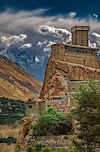Musical Instrument in Pakistan
Yaktaro, Dando, and Chaparoon/Kharrtaloon
While the Yaktaro, Dando, and
Chaparoon/Khartaloon are unmistakably various instruments customarily utilized
in Sindh, they are incorporated here together as they are played at the same
time to give both string and percussion. Frequently one individual will play
more than one of these instruments while additionally singing.
1) The "Yaktaro" is customarily a Sindhi 'single-stringed' "instrument", albeit a more refined structure has arisen with two strings which
is known by a similar name. The Yaktaro is formed from a round gourd,
frequently a pumpkin, which is dried, cut, and purged. A piece of arranged skin
is secured over the open piece of the gourd, and a long wooden bar is embedded
in the sound chamber. The strings are generally made of steel gotten around
wooden bars and stakes, and held by a semi-round help of dirt or metal which is
situated on the skin surface. Played as a string instrument, the pitch of the
tone is changed with the end stakes.
2) The Dando is one of two percussion instruments which can
go with the Yaktaro. This is a comprises of a wooden bar, roughly 2 to 2 ½ feet
long, and 1 inch in measurement. Ringers are hung and secured toward one side
through an opening in the pole. Beneath the gathering of chimes is a meager
circle of calfskin which goes about as a handle.
3) "Chaparoon" or Karrtaloon are a couple of rectangular
wooden pieces, around 6 inches wide and 3 centimeters thick. This is held by
the player in one hand and hit together to deliver cadenced beats (pictures and
data from Baloch 1988).
Naghara
The term 'naghara' is the Sindhi
type of the Arabic naqqarah. The adjusted segment of the naghara is made of
prepared mud, while the level side comprises of treated skin which is secured
around the edge with string which is fixed over the rear of the bowl.
This percussion instruments is many times played two by two,
where one naghara will create low pitch beats called nar (the male) and the
other for the high pitch bcats (the female). The instruments are beaten with
short wooden sticks bowed outward at the upper closures, called damka (picture
and data from Baloch 1988).
Dhul/Dhol/Dhole/Dholak
The Dhul or "Dhol" is a kind of
drum. The drum's sound chamber is regularly designed from a solitary piece of a
mango tree trunk. The two sides of the drum are shrouded in insult goatskin,
which is fixed with the arrangement of roundabout flexible sticks around the
external side. The bigger side of the drum is known as the 'bum' and the more
modest side the 'bone', while the wooden drumstick is known as a 'daunko'. The
conventional size of these drums was very huge, and they could purportedly be
heard a good ways off of 5 to 6 miles. Today the Dhul/Dhol in like manner use
in Sindh and the Punjab are more modest in size. The dhul/dhol likewise assumes
a significant part in a famous for of Punjabi music called bhangra (pictures
and data from Baloch 1988, data from Byrne 2003).
Sharnai
The "Sharnai" is a breeze instrument frequently utilized in
Sindh as a backup of the Dhul. In the past it was likewise called a Karnai.
The body of the Sharnai is made of wood with an embedded
reed sounding gadget. The instrument has eight openings organized in an orderly
fashion and a 10th opening, called the babiho, situated beneath on the rear.
There are three assortments of the Sharnai : 1) The Ghazzi is the littlest
assortment, around 6 inches long, and is utilized for playing the grieving
tunes for Muharram. 2) Sharnai is the medium assortment, around 8 inches long,
and the most widely recognized structure in the Indus Valley. 3) The Mutta,
around 10 inches long, is the structure most well known in additional northern
areas of Pakistan like the Multan district (picture and data from Baloch 1988).
Danburo/Kamach/Kamachi
The Danburo is a stringed
instrument customarily found in the Kohistan and Las Bela locales of Pakistan.
A more modest variant of this instrument of this sort (with a more modest
chamber and long tail) is called Kamach or Kamachi. The Danburo has an enormous
circular body made of wood, and three steel strings. It is most ordinarily
played utilizing a little wooden pick called the Janok (picture and data from
Baloch 1988).
Sarod
The Sarod is an instrument gotten
from the Focal and South Asian instrument the Rubab or Rabab. This string
instrument has a metal fingerboard without any frets, and various strings. The
layer covering gives reverberation in the sound chamber. It is typically played
with a coconut pick. The Sarod is utilized in many pieces of Pakistan including
Baluchistan and Azad Kashmir (first picture from Bina, second picture and data
from Courtney 2004).
The chimta is one more percussion
instrument regularly utilized in the well known Punjabi type of music called
bhangra. This is an instrument made of two long level bits of metal, ordinarily
iron, with pointed closes on one side and a ring on the opposite end. At the
edges of the metal strips are ringers or approximately appended basic metal
pieces. The player holds the joint in one hand and strikes the different sides
together to deliver a ringing sound (data from Nagpal, picture from Indian
Musicals 1998).
Tambur
The "tambur" is a stringed instrument which is many times
utilized in Afghanistan as well as Pakistan. It can have a changing number of
strings, generally around eighteen, which can be made of metal, creature guts,
or nylon. These strings are situated over a resounding chamber which is
frequently made of an emptied gourd. The tambur has a long, empty wooden neck
which has tuning stakes as an afterthought. It is much of the time utilized
either as a performance instrument or as a backup for voice pieces (Data and
picture from Gold and Schalliol 2004).






0 Comments